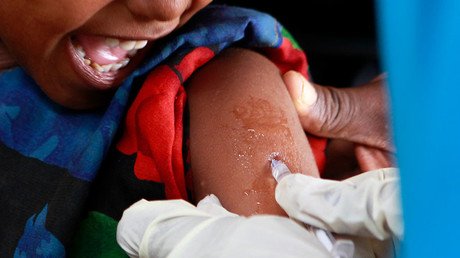Hate needles? Self-administered, painless vaccine skin patch passes 1st human clinical trials

Scientists hope an experimental Band-Aid-like patch that delivers the flu vaccine could increase the number of adults who get vaccinated by providing an alternative to the conventional needle-and-syringe immunization.
On Tuesday, a team of researchers at the Georgia Institute of Technology and Emory University published a study in the Lancet, detailing the results of the first clinical trial of their flu jab patch.
Ouch-less flu vaccines? Emory clinical trial finds flu vaccine via microneedle patches is effective and preferred https://t.co/u0IY3vxMsopic.twitter.com/JIHlDvN0fh
— Emory University (@EmoryUniversity) June 28, 2017
The flu jab patch uses 100 water-soluble needles that are only long enough to penetrate the skin, unlike a standard flu injection that would penetrate through the skin and into the muscle.
The needles dissolve in the skin, delivering the influenza vaccine painlessly and without the need for doctor supervision. Unlike a standard flu jab, the patch can be transported and stored without refrigeration for at least one year.
For their Phase 1 clinical trial, the team divided 100 volunteers between the age of 18 and 49 into four random groups: one group was given a patch by a health care worker, another self-administered the patch, another was given a placebo patch, and another was given a conventional flu jab with a needle administered by a health care worker.
The team found that the patches were not only safe and well-tolerated by the participants, but were just as effective at generating immunity against influenza as a standard flu injection.
Most of the participants said using the patch was pain-free and more than 70 percent said they would prefer it over injection or intranasal vaccination for future vaccinations.
The only adverse events reported in the study were localized skin reactions that consisted of “mostly faint redness and mild itching that lasted two to three days,” according to a statement from Georgia Tech.
In the clinical trial, the team studied blood samples from the 100 participants and found “no significant difference” in the antibody responses between the groups that received vaccinations through the patch and the needle.
The team also studied images of the used patches and found that the microneedles had all dissolved in the skin, suggesting that the participants were able to self-administer the patch correctly.
With only 40 percent of adults in the US receiving their yearly flu shots, the team hopes that the easy-to-use patches will revolutionize the way vaccines are administered in the future. The patch was made to help those who are afraid of needles or dislike doctors, or those who find it inconvenient to travel somewhere and wait in line to get a shot.
“One of the main goals of developing the microneedle patch technology was to make vaccines accessible to more people,” said Mark Prausnitz, professor of chemical and biomolecular engineering at Georgia Tech and senior co-author of the study. “With the microneedle patch, you could pick it up at the store and take it home, put it on your skin for a few minutes, peel it off and dispose of it safely, because the microneedles have dissolved away.”
Roderic Pettigrew, director of the National Institute of Biomedical Imaging and Bioengineering (NIBIB), which funded the study, said the patch could “transform how we get vaccinated.”
"A particularly attractive feature is that this vaccination patch could be delivered in the mail and self-administered,” Pettigrew said, according to ScienceDaily. “In addition, this technology holds promise for delivering other vaccines in the future.”













